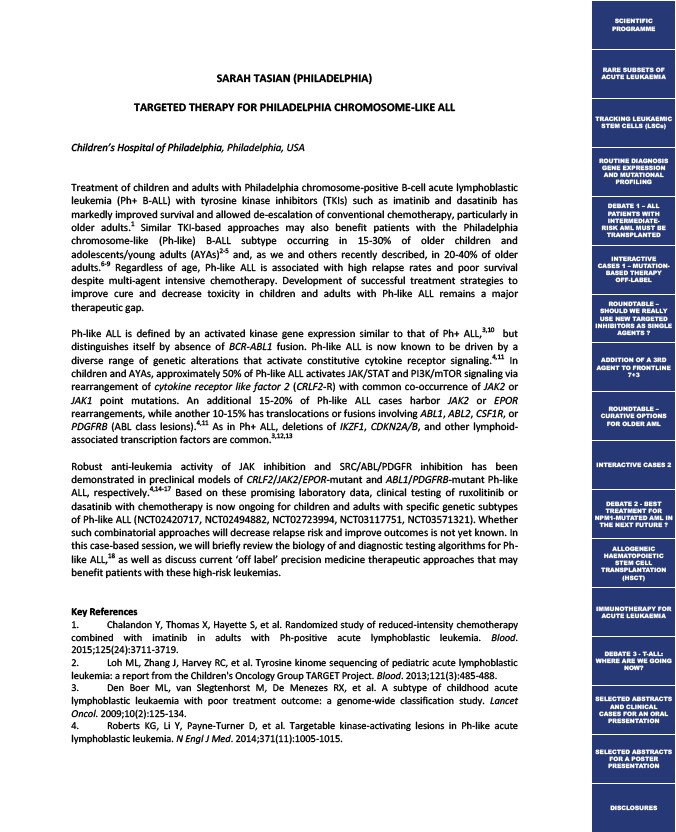
SARAH TASIAN (PHILADELPHIA)
TARGETED THERAPY FOR PHILADELPHIA CHROMOSOME-LIKE ALL
Children’s Hospital of Philadelphia, Philadelphia, USA
Treatment of children and adults with Philadelphia chromosome-positive B-cell acute lymphoblastic
leukemia (Ph+ B-ALL) with tyrosine kinase inhibitors (TKIs) such as imatinib and dasatinib has
markedly improved survival and allowed de-escalation of conventional chemotherapy, particularly in
older adults.1 Similar TKI-based approaches may also benefit patients with the Philadelphia
chromosome-like (Ph-like) B-ALL subtype occurring in 15-30% of older children and
adolescents/young adults (AYAs)2-5 and, as we and others recently described, in 20-40% of older
adults.6-9 Regardless of age, Ph-like ALL is associated with high relapse rates and poor survival
despite multi-agent intensive chemotherapy. Development of successful treatment strategies to
improve cure and decrease toxicity in children and adults with Ph-like ALL remains a major
therapeutic gap.
Ph-like ALL is defined by an activated kinase gene expression similar to that of Ph+ ALL,3,10 but
distinguishes itself by absence of BCR-ABL1 fusion. Ph-like ALL is now known to be driven by a
diverse range of genetic alterations that activate constitutive cytokine receptor signaling.4,11 In
children and AYAs, approximately 50% of Ph-like ALL activates JAK/STAT and PI3K/mTOR signaling via
rearrangement of cytokine receptor like factor 2 (CRLF2-R) with common co-occurrence of JAK2 or
JAK1 point mutations. An additional 15-20% of Ph-like ALL cases harbor JAK2 or EPOR
rearrangements, while another 10-15% has translocations or fusions involving ABL1, ABL2, CSF1R, or
PDGFRB (ABL class lesions).4,11 As in Ph+ ALL, deletions of IKZF1, CDKN2A/B, and other lymphoid-associated
transcription factors are common.3,12,13
Robust anti-leukemia activity of JAK inhibition and SRC/ABL/PDGFR inhibition has been
demonstrated in preclinical models of CRLF2/JAK2/EPOR-mutant and ABL1/PDGFRB-mutant Ph-like
ALL, respectively.4,14-17 Based on these promising laboratory data, clinical testing of ruxolitinib or
dasatinib with chemotherapy is now ongoing for children and adults with specific genetic subtypes
of Ph-like ALL (NCT02420717, NCT02494882, NCT02723994, NCT03117751, NCT03571321). Whether
such combinatorial approaches will decrease relapse risk and improve outcomes is not yet known. In
this case-based session, we will briefly review the biology of and diagnostic testing algorithms for Ph-like
ALL,18 as well as discuss current ‘off label’ precision medicine therapeutic approaches that may
benefit patients with these high-risk leukemias.
Key References
1. Chalandon Y, Thomas X, Hayette S, et al. Randomized study of reduced-intensity chemotherapy
combined with imatinib in adults with Ph-positive acute lymphoblastic leukemia. Blood.
2015;125(24):3711-3719.
2. Loh ML, Zhang J, Harvey RC, et al. Tyrosine kinome sequencing of pediatric acute lymphoblastic
leukemia: a report from the Children's Oncology Group TARGET Project. Blood. 2013;121(3):485-488.
3. Den Boer ML, van Slegtenhorst M, De Menezes RX, et al. A subtype of childhood acute
lymphoblastic leukaemia with poor treatment outcome: a genome-wide classification study. Lancet
Oncol. 2009;10(2):125-134.
4. Roberts KG, Li Y, Payne-Turner D, et al. Targetable kinase-activating lesions in Ph-like acute
lymphoblastic leukemia. N Engl J Med. 2014;371(11):1005-1015.
SCIENTIFIC
PROGRAMME
RARE SUBSETS OF
ACUTE LEUKAEMIA
TRACKING LEUKAEMIC
STEM CELLS (LSCs)
ROUTINE DIAGNOSIS
GENE EXPRESSION
AND MUTATIONAL
PROFILING
DEBATE 1 – ALL
PATIENTS WITH
INTERMEDIATE-RISK
AML MUST BE
TRANSPLANTED
INTERACTIVE
CASES 1 – MUTATION-BASED
THERAPY
OFF-LABEL
ROUNDTABLE –
SHOULD WE REALLY
USE NEW TARGETED
INHIBITORS AS SINGLE
AGENTS ?
ADDITION OF A 3RD
AGENT TO FRONTLINE
7+3
ROUNDTABLE –
CURATIVE OPTIONS
FOR OLDER AML
INTERACTIVE CASES 2
DEBATE 2 - BEST
TREATMENT FOR
NPM1-MUTATED AML IN
THE NEXT FUTURE ?
ALLOGENEIC
HAEMATOPOIETIC
STEM CELL
TRANSPLANTATION
(HSCT)
IMMUNOTHERAPY FOR
ACUTE LEUKAEMIA
DEBATE 3 - T-ALL:
WHERE ARE WE GOING
NOW?
SELECTED ABSTRACTS
AND CLINICAL
CASES FOR AN ORAL
PRESENTATION
SELECTED ABSTRACTS
FOR A POSTER
PRESENTATION
DISCLOSURES